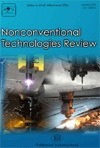VIBRATION MODES FEM ANALYSIS OF THE ULTRASONIC TRANSDUCER USED TO REDUCE THE FRICTION FORCE DURING WIRE DRAWING
Abstract
The article presents the determination and study of the natural vibration frequencies of an ultrasonic system that will be used in the "ultrasonic lubrication" necessary to reduce the coefficient of friction when drawing wires. Obtaining wires through wire drawing has been and will develop more and more strongly as an absolutely necessary industry, especially in the context of the transition to green energy involving photovoltaic panels and wind power plants. Along with their development, there is an absolutely imperative need to transport electricity from the place of its production to the points of its transformation or use. In this sense, the distances to be covered are of the order of hundreds of Km or even more. The companies in this industry, and here we can note the company Prysmian from Slatina, have already signed contracts for the next five years for the production of aluminum or copper cables. The research in this field comes to offer a solution to the reduction of the forces necessary for wire drawing by installing such ultrasonic systems within the wire drawing machines.
References
2. Takashi Jimma, Yukio Kasuga, Nobuyoshi Iwaki, Osamu Miyazawa, Eiji Mori, Katsuhiko Ito, Hajime Hatano, An application of ultrasonic vibration to the deep drawing process, Journal of Materials, rocessing Technology, Volumes 80–81, Pages 406-412, (1998)
3. C.L. Yang, C.S. Wu, L. Shi, Analysis of friction reduction effect due to ultrasonic vibration exerted in friction stir welding, Journal of Manufacturing Processes, Volume 35, Pages 118-126, (2018)
4. Kenneth S. Suslick, The Chemical Effects of Ultrasound, Scientific American Vol. 260, No. 2, pp. 80-87, (1989)
5. Yi Wang, Bo Qin, Mao Chang Wu, Jian Song, Ping Zou and Ming Hu, Journal: Advanced Materials Research, Volume 338, Page 656, (2011)
6. Pingqing Fan and Keshuai Zhou, Journal: AIP Advances, Volume 10, Number 1, Page 015054, DOI: 10.1063/1.5128699, (2020)
7. Hanlu Li, Weihao Ren, Lin Yang, Chengcheng Ma, Siyu Tang and Ruijia Yuan, Journal: Proceedings of the Institution of Mechanical Engineers, Part C: Journal of Mechanical Engineering Science, Volume 235, Number 19, Page 4337, (2021)
8. Heywang, Walter, Karl Lubitz, and Wolfram Wersing, eds. Piezoelectricity: evolution and future of a technology. Vol. 114. Springer Science & Business Media, (2008)
9. R. E. Eitel; T. R. Shrout; C. A. Randall, Nonlinear contributions to the dielectric permittivity and converse piezoelectric coefficient in piezoelectric ceramics, Journal of Applied Physics 99, 124110, (2006)
10. S. J. Rupitsch and J. Ilg, "Complete characterization of piezoceramic materials by means of two block-shaped test samples," IEEE Transactions on Ultrasonics, Ferroelectrics, and Frequency Control, vol. 62, no. 7, pp. 1403-1413, July (2015)
11. J A Gallego-Juarez, Piezoelectric ceramics and ultrasonic transducers, Published under licence by IOP Publishing Ltd, Journal of Physics E: Scientific Instruments, Volume 22, Number 10, (2020)
12. B. Chandra Sekhar, B. Dhanalakshmi, B. Srinivasa Rao, S. Ramesh, K. Venkata Prasad, P.S.V. Subba Rao and B. Parvatheeswara rao, Multifunctional Ferroelectric Materials, Piezoelectricity and its applications, Submitted: October 9th, 2020 Reviewed: January 22nd, 2021 Published: September 8th, (2021)
13. Aabid, A.; Raheman, M.A.; Ibrahim, Y.E.; Anjum, A.; Hrairi, M.; Parveez, B.; Parveen, N.; Mohammed Zayan, J. A Systematic Review of Piezoelectric Materials and Energy Harvesters for Industrial Applications. Sensors (2021)
14. Aabid, A.; Parveez, B.; Raheman, A.; Ibrahim, Y.E.; Anjum, A.; Hrairi, M.; Parveen, N.; Zayan, J.M. A review of piezoelectric materials based structural control and health monitoring techniques for engineering structures: Challenges and opportunities. Actuators, 10, 26
(2021)

